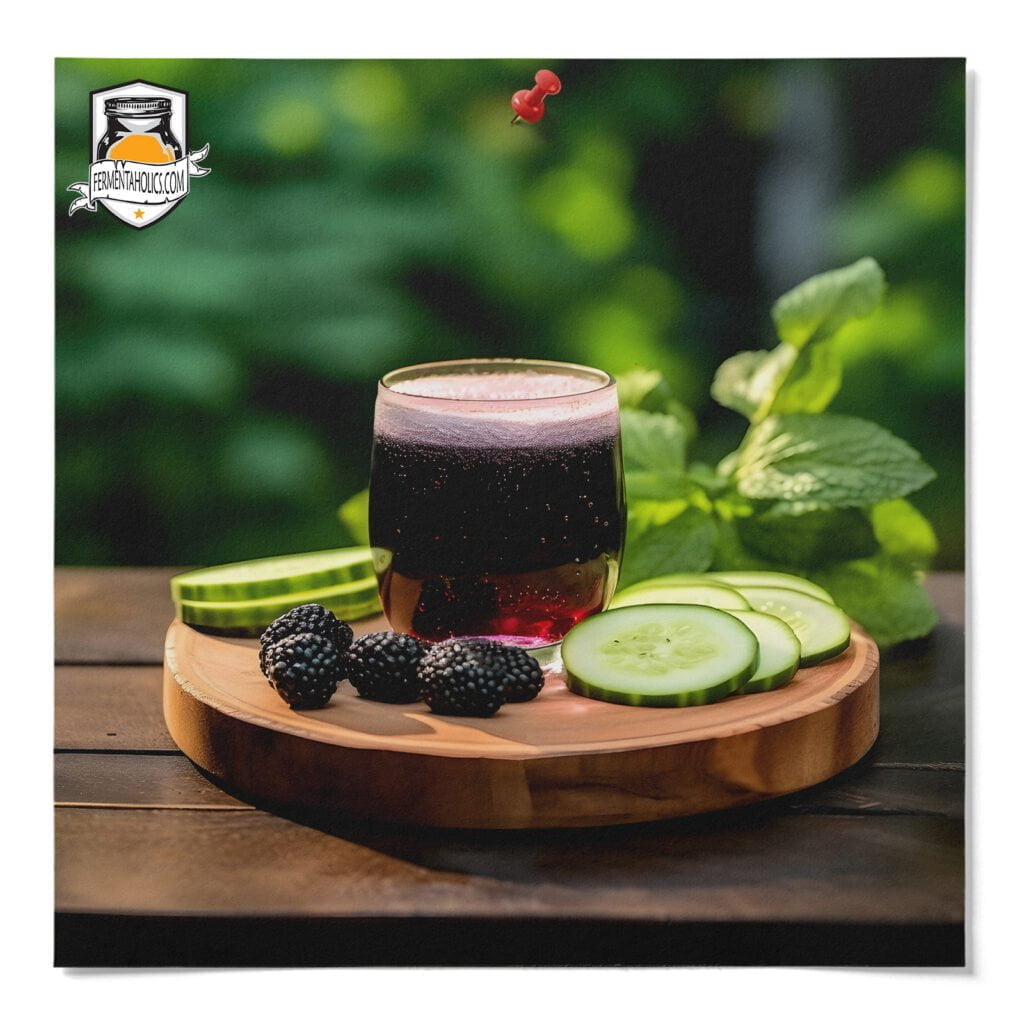
Dark, rich purple and blue tones of blackberries with the vibrant greens of cucumber, you can be sure that this drink will look as beautiful as it tastes! The juxtaposition of flavor profiles of these two ingredients creates a flavor experience unique compared to other Kombucha recipes, and the sweet earthiness of blackberries combines with the natural flavors of kombucha in a very delightful way.
Whether you are sipping poolside or bundled up on the couch, this is the perfect beverage to satisfy and comfort your tastebuds.
It’s important to note that making homemade kombucha is almost always a two-step fermentation process. Brewing kombucha is only a one-step process for those who prefer an unflavored flat kombucha. Otherwise, the steps consist of a primary fermentation and a secondary fermentation.
Primary fermentation is the first step of the kombucha brewing process. This is where your SCOBY transforms regular sweet tea into the tart and slightly sweet kombucha we love. At the end of this stage, you will have finished kombucha, but it will be flat and unflavored. Have you skipped this step? Then check out our guide on how to make kombucha at home, and for jun kombucha, see our post on how to make jun kombucha tea at home. Traditional kombucha is going to yield a bolder brew, while jun kombucha is milder and can be a bit tarter.
Secondary fermentation is the step where you bottle, carbonate, and flavor your kombucha with the addition of sugar and flavors. In this step, the finished kombucha from the primary is mixed with sugar, fruits, or other flavors before bottling it with specialized lids that can hold pressure, like flip-top bottles. The bottled kombucha is then left at room temperature for natural fermentation, where yeast carbonates the kombucha within the sealed bottle. The ideal temperature range for this process is between 75-85°F. The amount of time needed to carbonate within the bottle is highly tied to temperature, which can take anywhere from 2-10 days.
💡Since this recipe is for the secondary fermentation, to make this recipe, you’ll need to have kombucha that has finished the primary fermentation and is ready to bottle.
This recipe makes one 16 fluid ounce bottle. For a 1-gallon batch, make 7 16 ounce bottles of kombucha or times the ingredients by 7. Before beginning this recipe, prepare the following:
16 FL Oz Bottles
10
minutes2-10 Days
This blackberry cucumber kombucha recipe is for one 16 fluid ounce bottle. For a gallon batch, make seven bottles. To scale this recipe to a gallon batch, multiply the ingredients by seven or toggle the serving size up to seven above. Before bottling your kombucha, remove the SCOBY pellicle along with 12-16 ounces of kombucha starter tea from your brew, and reserve for your next batch
1 – 2 inch slice Fresh Cucumber
4-5 individual Fresh Blackberries
1 – 16 oz Kombucha Bottles
Blender
You can either puree the blackberries and cucumbers together in a high-speed blender or chop up finely, all depending on whether you want the final product altogether or strained before drinking. We recommend testing out both to find out your favorite!
Place clean 16 oz bottle in the sink.
Add the blackberry and cucumber mixture into each bottle.
Using a funnel, slowly pour kombucha from your brew jar into the bottles, ensuring there is about one inch of headspace left from the top of each bottle. The kombucha may foam up as you pour so be sure to pour carefully.
Tightly place caps on each bottle.
Keep bottles at room temperature for 2-10 days; it will carbonate faster at higher temperatures and slower when cold.
Burp the bottles as necessary to release excess pressure. This is done by removing the cap to allow built-up pressure to escape then placing the cap back on.
Chill in the refrigerator once you’re happy with the carbonation levels. Based on preference, you can serve as is or strain before drinking.
